| THE ING NEWSLETTER | No. 3, September 2000 |
|
|
SCIENCE |
|
|
|
| Previous: | Photometric Redshifts: A Comparison of Methods | Up: | Table of Contents | Next: | NAOMI Progress |
Other available formats: PDF | gzipped Postscript
First Light of INGRID on the WHT !
René Rutten and Gordon Talbot (ING)
The
popularity of competitive IR imaging led to the development of a new IR
imager for the WHT, called INGRID: the Isaac Newton Group Red Imaging Device.
INGRID was conceived both as a moderately wide field imager as well as
the prime detector to take high resolution images with the future adaptive
optics system. This instrument was recently commissioned, with great success.
INGRID saw its first light on the telescope in March 2000. Coincidentally,
the first observations with INGRID occurred a little after the 200th anniversary
of the discovery of infrared
light by Sir William Herschel.
 |
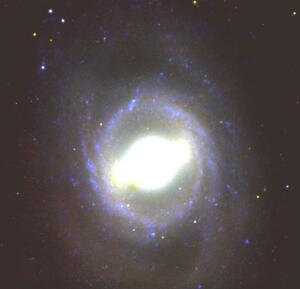 |
| Figure 1. The proud INGRID commissioning team of engineers and astronomers (and the Tasmanian Devil Mascot) in the WHT control room during the first successful observations. [ JPEG | TIFF ] | Figure 2. This false colour image, acquired on the first nights, shows the morphology of the barred spiral galaxy Messier 95. Young stars and sites of current star formation show up as blue regions, with the inner ring featuring prominently. The infrared light, measured with INGRID, traces dustlanes in the galaxy, and the older stellar populations. The dust lanes, lacking blue emission, are seen as brownish red in the image; the bar is made up of old stars and shows up as white. Picture credit: Johan Knapen (ING and University of Hertfordshire). [ JPEG | TIFF ] |
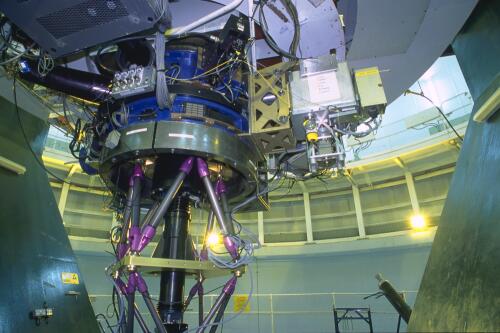 |
|
| Figure 3. INGRID mounted on one of the WHT folded Cassegrain foci (top right). The instrument on the Cassegrain focus is SAURON. Picture credit: Rainer Girnstein. [ JPEG | TIFF ] | |
With the advent of INGRID the WHT possesses a powerful state-of-the-art IR imager for wavelengths between 0.8 and 2.5 micron. At the heart of INGRID is a 1024 × 1024 pixel HgCdTe "Hawaii" array from Rockwell. Its field-of-view is a luxurious 4.3 by 4.3 arcmin, which makes it very attractive for moderately wide-field imaging and small scale survey activities. The corresponding pixel size in the Cassegrain focus is 0.24 arcsec, designed to sample the typical good seeing conditions well.
INGRID has a closed-cycle cooler
as well as a liquid nitrogen tank to achieve the required low temperatures
of 77 Kelvin for the detector and the optics. The closed-cycle cooler is
essentially a single-stage refrigeration unit whereby the heat is taken
away through high pressure helium pipes that run from the telescope to
a heat exchange unit and pump outside the telescope building. Liquid nitrogen
is used to achieve fast cool-down of the instrument and when INGRID has
to work under minimum vibration conditions, for instance when used in conjunction
with the adaptive optics system.
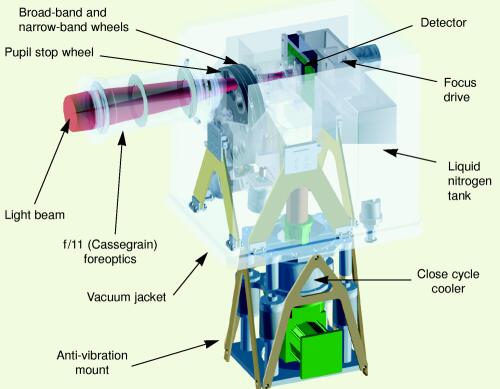 |
| Figure 4. A 3-D transparent model of INGRID showing in red the light beam from the telescope focusing on the infrared detector. Picture credit: Paul Jolley (ING). [ JPEG | TIFF ] |
INGRID will be deployed at two focal stations: at the (folded) Cassegrain focus and at the Nasmyth focus, integrated with the NAOMI adaptive optics system.
In the Cassegrain focus INGRID is mounted on the side of the Acquisition and Guiding unit together with other Cassegrain mounted instruments such as the ISIS spectrograph or visiting instruments such as SAURON. A flip mirror reflects light from the telescope into INGRID. At the opposite side of the A&G unit there is the Auxiliary port optical camera. The standard Cassegrain instrumentation package therefore makes a very powerful setup, combining optical spectroscopy with optical and IR imaging without the need of an instrument change. It is our intention to have the instrument available as much of the time as possible at Cassegrain. But there will of course be periods when INGRID will be used for adaptive optics observations in the Nasmyth focus.
The INGRID optics consist of warm collimating fore-optics that are interchangeable to accommodate the f/11 Cassegrain focus and the much slower adaptive optics focus. There are two filter wheels and a pupil-stop wheel. A pupil imager is foreseen as well to allow accurate alignment, particularly for adaptive optics, but this option is not commissioned yet. Available filters are broadband Z, J, H, K and K-short, and narrow band H continuum, [FeII], Bracket-gamma and K continuum. More narrow band filters are on order. At the time of writing the large volume of commissioning data is still being worked on. A preliminary users manual and other information can be found at: http://www.ing.iac.es/Astronomy/instruments/ingrid/
Development of INGRID has been an interesting experience, with many ups-and-downs. The instrument got tangled up in the closure of the Royal Greenwich Observatory, which resulted in significant delays as people left and priorities shifted. In the end there was no alternative as for ING to complete the instrument in-house, on La Palma. With assistance from the Astronomy Technology Centre in Edinburgh and the Spanish Instituto de Astrofísica de Canarias on Tenerife the ING, thanks to the huge amount of effort and enthusiasm of everyone involved, brought the instrument to fruition. Despite the tribulations it is satisfying to note that INGRID took its first glance of the universe only minutes after opening the dome on the first commissioning night. This marked the start of an almost faultless commissioning run.
Funding for INGRID has come from PPARC's instrument development line, and PPARC have been most supportive during the difficult development phase.
The success and popularity of this new instrument may be measured from the immediate science exploitation shortly after commissioning, and from the many requests to use INGRID during the following semester. This has led to an oversubscription of UK bright time on the WHT for semester 2000B of more than a factor 6 (!), something we've never seen before.
Two early science examples obtained
with INGRID are shown in the accompanying pictures: Figure
5 shows observations of the massive galaxy cluster Abell 2218 with
various gravitational arcs around the most massive galaxies. The second
example, Figures 2 and 6,
is that of the relatively nearby galaxy M95, combining optical and IR images,
bringing out star-forming regions and detailed galaxy morphology.
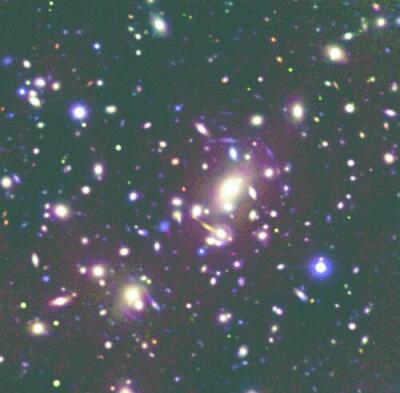 |
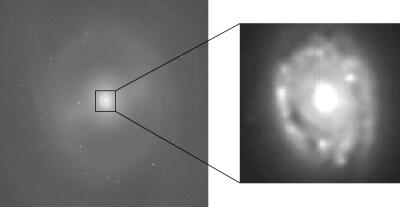 |
| Figure 5. This image is a combination of a blue (B-band) frame acquired using a CCD on the WHT Cassegrain focus with two near-infrared exposures in the J- and K-bands obtained with INGRID with the B (0.4µm), J (1.2µm), and K (2.2µm) images coded as blue, green and red. The field of view of this image is 3 arcminutes, corresponding to 2 million light years across at the distance of the cluster. The INGRID exposure times totalled 4 hours in J and 2.5 hours in K under good sky conditions (better than 0.8 arcsecond seeing). Picture credit: Ian Smail (University of Durham) and Chris Packham (ING). [ JPEG | TIFF ] | Figure 6. The image on the left is an INGRID J-band image of M95. The inset on the right shows the nuclear ring of enhanced star formation (see also Figure 2). Picture credit: Johan Knapen (ING and University of Hertfordshire). [ JPEG | TIFF ] |
Although having been commissioned in the Cassegrain focus, INGRID is not finished yet. First of all at the time of commissioning INGRID's data acquisition system was a stand-alone system controlled from a Unix Sparc station. The final system will have a higher level of integration with other parts of the observing system and more functionality built in (such as windowing).
Also one component of the collimating fore optics will need to be replaced. The aspheric lens in the original design turned out to be very difficult to manufacture to the tight tolerances, and therefore a backup lens was used instead. Now the aspheric lens has been delivered and, if passed acceptance testing, we plan to install it early next year. This will provide somewhat better image quality, but more importantly, the K-band thermal background is expected to be lower.
And of course INGRID is still awaiting commissioning with the NAOMI adaptive optics system in August and September.
Finally, it's worth mentioning the 'heroes' of INGRID: Chris Packham played a key role as project scientist. He has recently taken up a post at the University of Florida, but will be back to observe with 'his' INGRID. Mechanics and optical alignment work was largely carried out by Kevin Dee, Paul Jolley, Mariet Broxterman and Bart van Venrooy. Sue Worswick (ATC) and Richard Bingham (UCL) helped address various optics-related problems and queries. Peter Moore (with assistance from Derek Ives at the ATC) brought the detector under control, and Simon Rees, Matthieu Bec, Guy Rixon, Robert Greimel and Marti Pi i Puig (IAC/GTC) ensured that there was software to control the instrument and the detector. Also we should not forget the efforts initially at the Royal Greenwich Observatory, where Simon Craig (now ATC) was project manager and Keith Thompson (now Stanford) was project scientist when INGRID was kicked off.
Email contact: René Rutten (rgmr@ing.iac.es)
| Previous: | Photometric Redshifts: A Comparison of Methods | Up: | Table of Contents | Next: | NAOMI Progress |
| GENERAL | SCIENCE | TELESCOPES AND INSTRUMENTATION | OTHER NEWS FROM ING | TELESCOPE TIME |